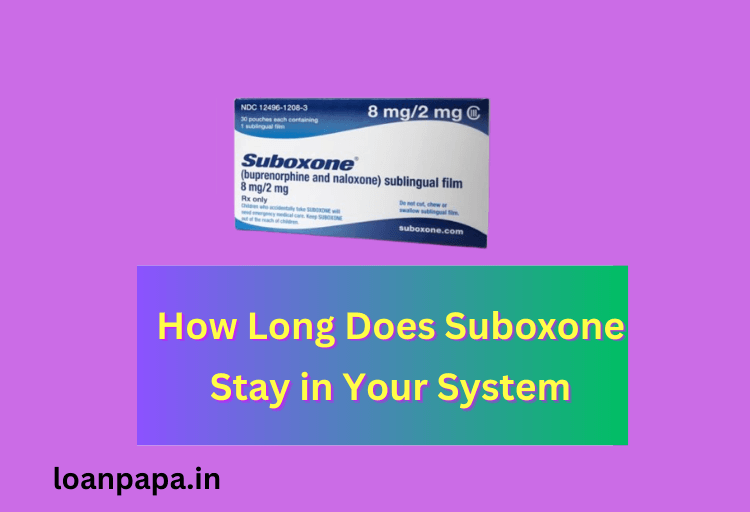
Table of Contents
How Long Does Suboxone Stay in Your System
How Long Does Suboxone Stay in Your System: Suboxone is a medication used to treat opioid dependence and addiction. It contains a combination of buprenorphine and naloxone, which helps in reducing withdrawal symptoms and cravings for opioids. If you or someone you know is considering using Suboxone or has recently taken it, you might be wondering how long it stays in the system. In this article, we will explore the factors that affect the duration of Suboxone in the body and provide valuable insights into its detection.
1. Understanding Suboxone and its Mechanism
Before delving into its elimination from the body, it’s essential to understand how Suboxone works. Buprenorphine, a partial opioid agonist, attaches to the brain’s opioid receptors, reducing the cravings and withdrawal symptoms experienced during opioid addiction. Naloxone, on the other hand, is an opioid antagonist, which blocks the effects of opioids and prevents misuse of Suboxone.
2. Half-Life of Suboxone
The half-life of a drug refers to the time it takes for its concentration in the body to reduce by half. For Suboxone, the average half-life of buprenorphine is around 24 to 42 hours, while naloxone has a much shorter half-life of approximately 2 to 12 hours. The combined effect of both drugs makes Suboxone a long-acting medication.
3. Factors Affecting Elimination
The duration for which Suboxone remains in the system can vary based on several factors, including:
A. Metabolism:
Individual differences in metabolic rates can influence how quickly Suboxone is broken down and eliminated from the body.
B. Frequency of Use:
Regular use of Suboxone can lead to its accumulation in the body, affecting the time it takes to clear.
C. Dosage:
Higher doses of Suboxone may take longer to eliminate than lower doses.
D. Duration of Use:
The longer someone has been taking Suboxone, the more time it might take for the body to completely clear it.
E. Individual Factors:
Each person’s physiology and health condition play a role in the drug’s clearance rate.
4. Detection in Different Tests
Suboxone can be detected in various drug tests, including urine, blood, saliva, and hair tests. The detection window varies for each test:
A. Urine Test:
Suboxone can be detected in urine for up to 2 to 4 days after the last dose.
B. Blood Test:
In a blood test, Suboxone can be detected for about 24 hours after use.
C. Saliva Test:
Saliva tests can detect Suboxone for up to 1 to 3 days after use.
D. Hair Test:
Hair tests have a longer detection window, and Suboxone can be detected in hair for up to 1 to 3 months after use.
5. Withdrawal Symptoms
After discontinuing Suboxone use, some individuals may experience withdrawal symptoms. These can include nausea, vomiting, diarrhea, muscle aches, anxiety, and sleep disturbances. The severity and duration of withdrawal symptoms can vary depending on individual factors.
FAQs (Frequently Asked Questions)
How long after last use of Suboxone can I take it?
After the last use of Suboxone, it is generally safe to take another dose when the next scheduled dose is due, following the prescribed dosing regimen. It’s crucial to avoid taking extra doses to prevent potential adverse effects.
How long does a Suboxone take to dissolve?
Suboxone usually takes around 2 to 10 minutes to dissolve completely when placed under the tongue. It is essential not to chew or swallow the medication during the dissolving process to ensure its effectiveness.
What is the half life of buprenorphine?
The half-life of buprenorphine, a key component of Suboxone, typically ranges from 24 to 42 hours, meaning it takes that amount of time for the concentration of buprenorphine in the body to reduce by half after administration.
What can make you test positive for Suboxone?
Testing positive for Suboxone can occur if the individual has recently taken Suboxone as prescribed or if they have unknowingly ingested the medication through secondary exposure, such as contact with someone using Suboxone or through contaminated surfaces.
How much Suboxone should I take a day?
The appropriate daily dosage of Suboxone depends on various factors, including the severity of opioid dependence and individual response to the medication. It is essential to follow the prescribed dosage given by a qualified healthcare professional for safe and effective treatment.
Conclusion
Suboxone is an essential medication for treating opioid dependence, but it’s essential to be aware of its presence in the body and how long it stays there. The half-life of buprenorphine and naloxone, along with individual factors, affects the duration of Suboxone in the system. Drug tests can detect Suboxone for varying periods, depending on the type of test used. If you are considering stopping Suboxone use, it’s advisable to work with a healthcare professional to ensure a safe and comfortable transition.
How can you reduce your total loan cost?
16 Devastating Facts About North Korea